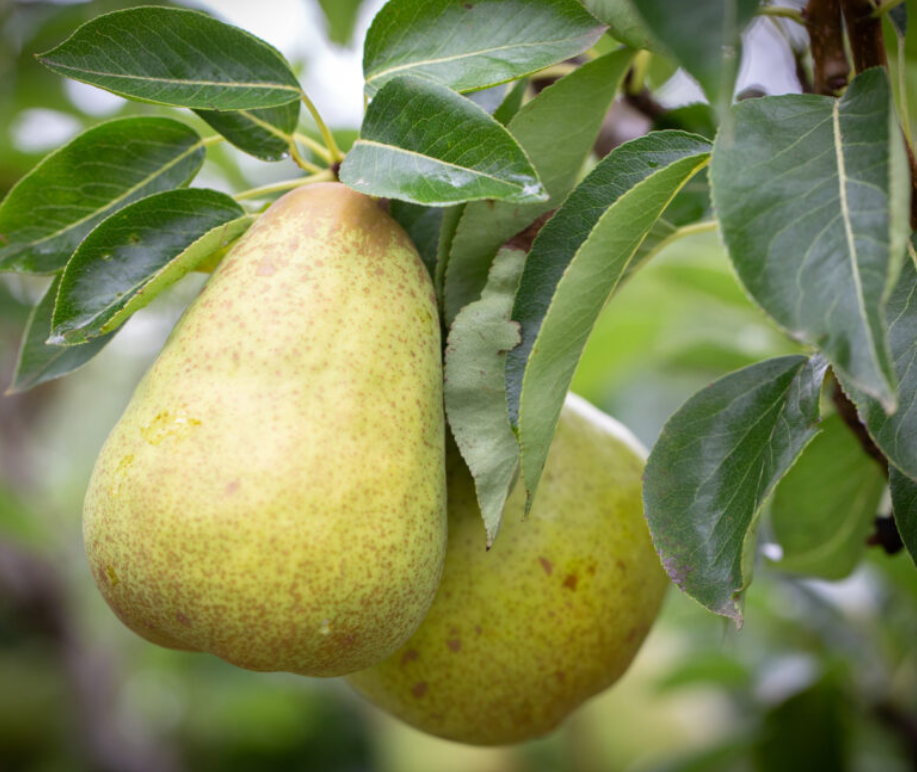 Image 1 of
Image 1 of


Pear - Williams' Bon Chretien
Description:Williams is one of the most popular old English pear varieties, most likely a variety to be on a supermarket shelf as fresh or tinned fruit. A great garden tree that produces regular crops of medium-large sized oval-shaped fruits. The smooth skin is pale green in colour turning golden yellow with a very juicy, sweet and refreshing flesh. Also hardy enough for nothern areas. Perfect for eating fresh but also good for poaching and preserving. The tree itself is compact in habit, has stunning white scented flowers in the spring and oval green leaves. An overall excellent early eating variety.
History:Originated from Aldermaston, Berkshire during the 18th Century. Discovered by Mr Wheeler, a schoolmaster, who found the seedling in his garden. The next schoomaster to have the garden, Mr Stair, sent the grafts to Richard Williams, a nurseryman of Turnham Green. The pear was then named after him. Recieved an Award of Garden Merit from the Royal Horticultural Society.
Pollination Partners:Pear Conference Pear Doyenne du Comice Pear Fondante d'Automne Pear Glou Morceau Pear Josephine de Malines Pear Louise Bonne of Jersey Pear Moonglow Pear Winter Nelis
Description:Williams is one of the most popular old English pear varieties, most likely a variety to be on a supermarket shelf as fresh or tinned fruit. A great garden tree that produces regular crops of medium-large sized oval-shaped fruits. The smooth skin is pale green in colour turning golden yellow with a very juicy, sweet and refreshing flesh. Also hardy enough for nothern areas. Perfect for eating fresh but also good for poaching and preserving. The tree itself is compact in habit, has stunning white scented flowers in the spring and oval green leaves. An overall excellent early eating variety.
History:Originated from Aldermaston, Berkshire during the 18th Century. Discovered by Mr Wheeler, a schoolmaster, who found the seedling in his garden. The next schoomaster to have the garden, Mr Stair, sent the grafts to Richard Williams, a nurseryman of Turnham Green. The pear was then named after him. Recieved an Award of Garden Merit from the Royal Horticultural Society.
Pollination Partners:Pear Conference Pear Doyenne du Comice Pear Fondante d'Automne Pear Glou Morceau Pear Josephine de Malines Pear Louise Bonne of Jersey Pear Moonglow Pear Winter Nelis
Description:Williams is one of the most popular old English pear varieties, most likely a variety to be on a supermarket shelf as fresh or tinned fruit. A great garden tree that produces regular crops of medium-large sized oval-shaped fruits. The smooth skin is pale green in colour turning golden yellow with a very juicy, sweet and refreshing flesh. Also hardy enough for nothern areas. Perfect for eating fresh but also good for poaching and preserving. The tree itself is compact in habit, has stunning white scented flowers in the spring and oval green leaves. An overall excellent early eating variety.
History:Originated from Aldermaston, Berkshire during the 18th Century. Discovered by Mr Wheeler, a schoolmaster, who found the seedling in his garden. The next schoomaster to have the garden, Mr Stair, sent the grafts to Richard Williams, a nurseryman of Turnham Green. The pear was then named after him. Recieved an Award of Garden Merit from the Royal Horticultural Society.
Pollination Partners:Pear Conference Pear Doyenne du Comice Pear Fondante d'Automne Pear Glou Morceau Pear Josephine de Malines Pear Louise Bonne of Jersey Pear Moonglow Pear Winter Nelis
